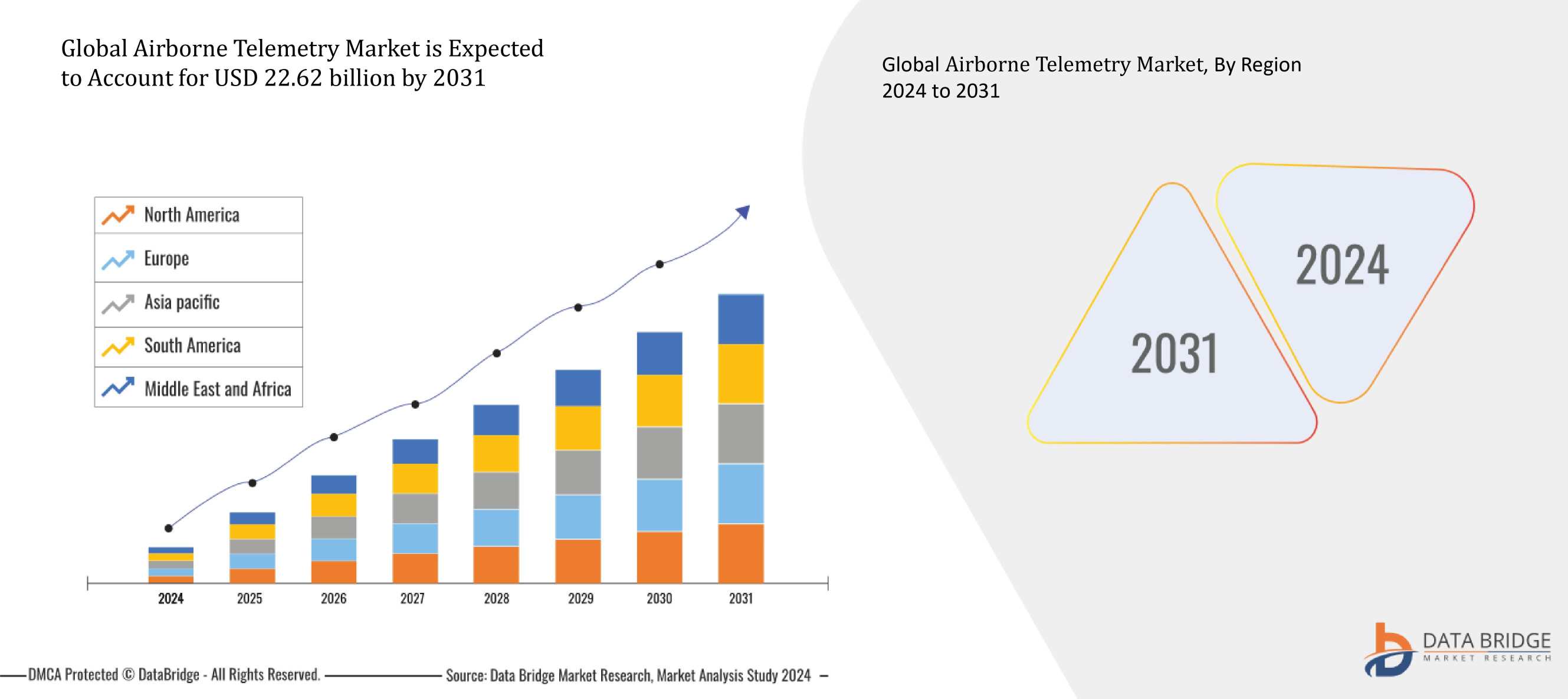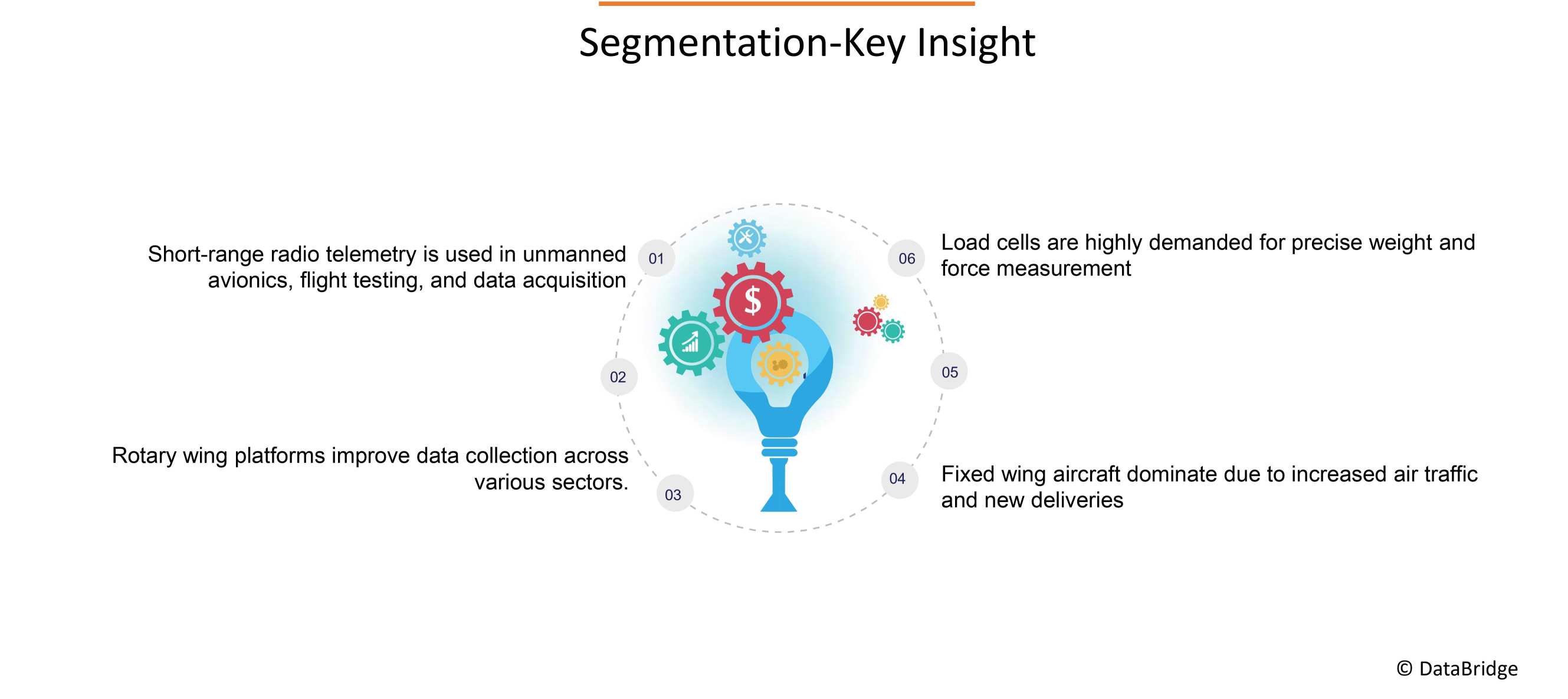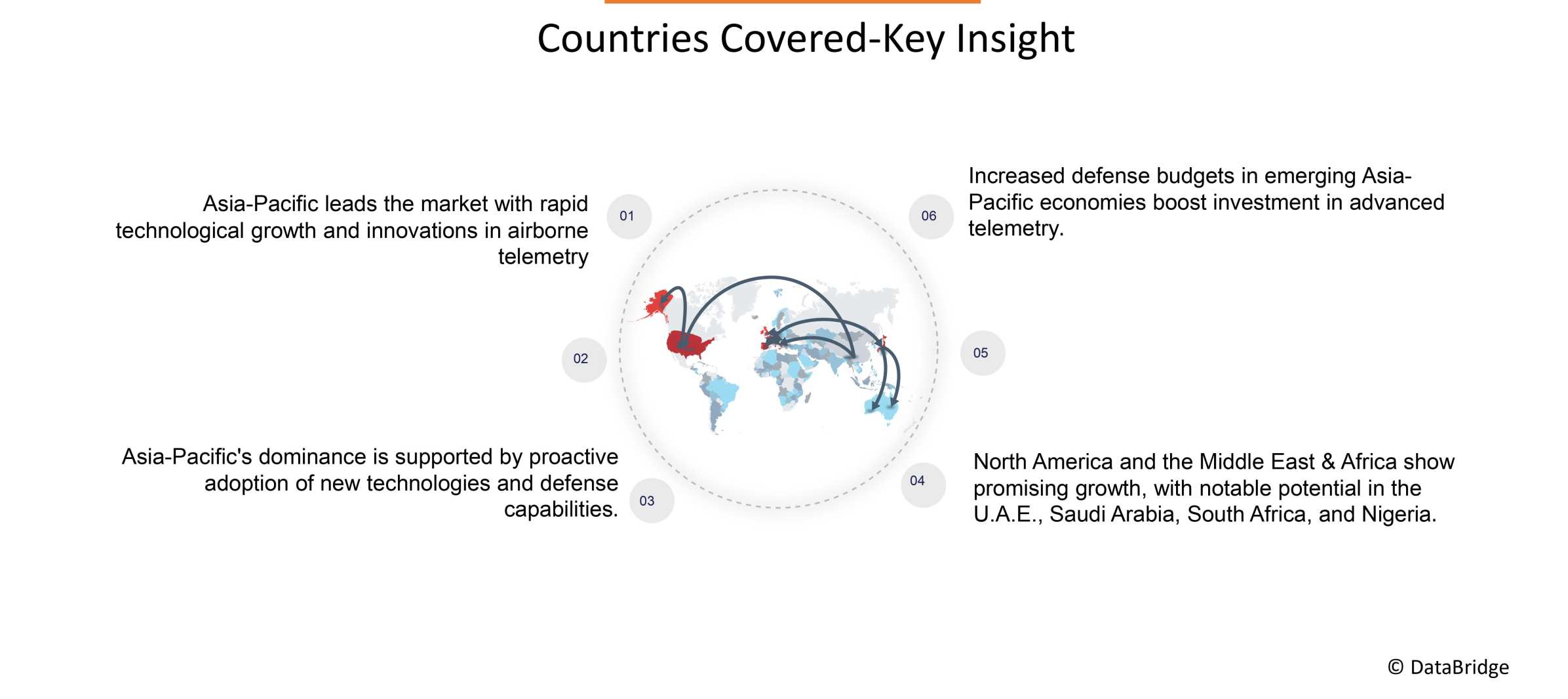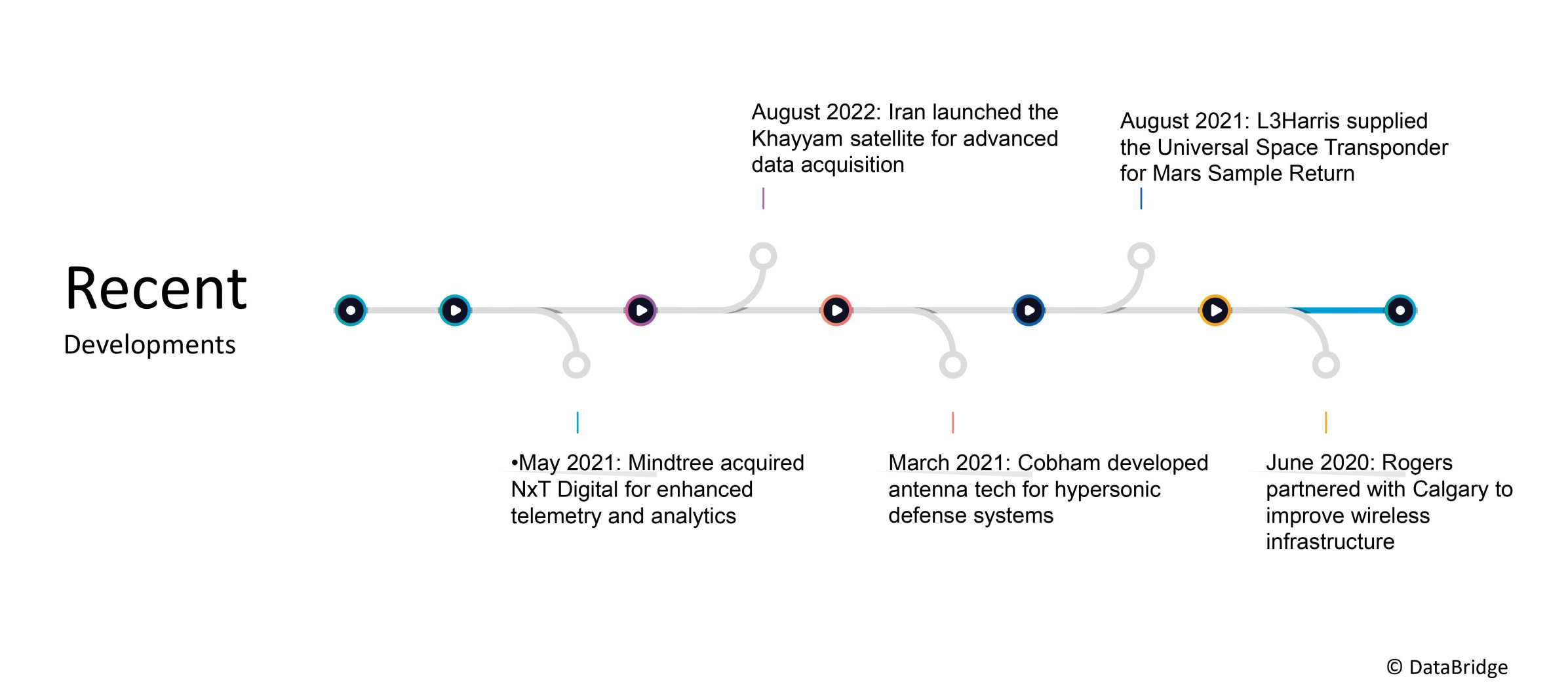Global Airborne Telemetry Market
Market Size in USD Billion
CAGR :
% 
 USD
8.52 Billion
USD
22.62 Billion
2023
2031
USD
8.52 Billion
USD
22.62 Billion
2023
2031
| 2024 –2031 | |
| USD 8.52 Billion | |
| USD 22.62 Billion | |
|
|
|
|
The Global Airborne Telemetry Market was valued at USD 8.52 Billion in 2023. The market size is projected to grow at a CAGR of 3.64% to reach USD 22.62 billion by 2031.
Airborne Telemetry Market Overview
Airborne telemetry is upgrading the way we gather and analyze data from the skies by transforming aircraft and spacecraft into high-tech data hubs. This cutting-edge technology allows for the real-time collection and transmission of vital information, such as velocity, altitude, and temperature, directly to ground stations for monitoring and analysis. Airborne telemetry systems are utilized across diverse fields, including mining, healthcare, aerospace, defense, and resource exploration. They employ various transmission mediums, such as radio frequencies and fiber optics, to maintain data integrity and reliability. Companies such as Mistral Solutions are at the forefront that offers rugged, modular telemetry systems designed to withstand harsh environments. Meanwhile, innovations such as bidirectional communication networks are enhancing data acquisition capabilities during flight tests.
Data Bridge Market research market report provides details of recent developments, trade regulations, market share, market trends on the basis of its segmentations and regional analysis, impact of market players, analysis of opportunities in terms of emerging revenue pockets, market regulations, strategic market growth analysis, market size, category wise market growths, application niches and dominance, product approvals, product launches, geographic expansions, and technological innovations in the market. To gain more info on the market, contact Data Bridge Market Research’s team of expert analysts. Our team will help you make informed market decisions to achieve business growth.
Global Airborne Telemetry Market Size
|
Global Airborne Telemetry Report Metric Details |
|
|
Forecast Period |
2024-2031 |
|
Base Year |
2023 |
|
Historic Year |
2022 (Customizable 2016-2021) |
|
Measuring Unit |
USD Million |
|
Data Pointer |
In addition to the market insights such as market value, growth rate, market segments, geographical coverage, market players, and market scenario, the market report curated by the Data Bridge Market Research team includes in-depth expert analysis, import/export analysis, pricing analysis, production consumption analysis, and pestle analysis. |
The rapid advancements in telemetry technology are making a significant impact on the growth of the airborne telemetry market. The efficiency of flight tests and operational monitoring is significantly enhanced by enabling higher data transmission rates and bidirectional communication. This surge in capabilities allows improved decision-making processes, which are critical in the aerospace sector. Databridge Market Research took a dive into comprehensively analyzing the market and unveiled that the global airborne telemetry market is increasing at a CAGR of 3.64%. The size of the market is valued at USD 8.52 billion in 2023 and is expected to grow up to USD 22.62 billion by 2031. The aerospace and defense segment are a major contributor to the growth of this sector because of their rising need for reliable and robust telemetry solutions. This trend underscores the increasing reliance on sophisticated telemetry systems to enhance operational efficiency and safety in aviation, ultimately propelling the market forward.
Airborne Telemetry Market Dynamics
Airborne Telemetry Market Growth Drivers
Various Advantages Impacting Airborne Telemetry Systems
Airborne telemetry systems provide advanced and automated communication capabilities that enables data collection and measurements without the need for physical presence. Their adoption is increasing due to the growing demand for real-time data and enhanced decision-making across various industries, including oil and gas, energy and power, mining, marine and oceanography, aerospace and defense, and healthcare. Continuous human monitoring in these fields is challenging. The reliance on human resources for physical data gathering is significantly reduced by the automated data collection and transmission from remote locations. This automation helps organizations to lower the operational costs. Wireless telemetry systems are also finding extensive use in disaster management.
For instance, incoming of the telemetry solutions designed for recording and transmitting data to remote ground stations. These custom-built, modular, and rugged systems are suitable for use in harsh defense and aerospace applications. These systems also enable the collection of data in harsh airborne flight test environments
Adoption of Wireless Medical Telemetry Services in Healthcare
The increasing demand for wireless medical telemetry services (WMTS) is driving growth in the airborne telemetry market by enhancing telemetry systems in healthcare. The need for real-time patient monitoring is rising due to the prevalence of chronic diseases and cardiovascular issues. Wireless telemetry allows continuous data transmission from mobile cardiac devices, enabling remote monitoring and immediate feedback for healthcare providers. This shift from wired to wireless systems improves patient care and cuts operational costs. To prevent interference, the Federal Communications Commission (FCC) has allocated 14 MHz of spectrum for WMTS in the 608–614 MHz, 1395–1400 MHz, and 1427–1432 MHz ranges. This dedicated spectrum ensures effective, disruption-free operation of medical telemetry devices that leads to market growth.
Growing Demand for Advanced Airborne Telemetry in Military Applications
The increasing use of telemetry in military applications is significantly driving the growth of the airborne telemetry market. The high security threats, including terrorism and geopolitical tensions require advanced telemetry systems in various military platforms such as guided missiles, armored vehicles, aircraft, and UAVs. This demand is further supported by increased defense spending and investments in telemetry analysis data software, which facilitate real-time data monitoring and analysis essential for operational effectiveness and pilot safety. Notably, satellite telemetry provides reliable communication links necessary for data transmission from onboard instruments in flight test missions. For instance, the launch of telemetry integrated systems emphasize the importance of satellite communication in enhancing weather and climate data tracking, which is vital for military applications. With the expansion of satellite communication capabilities and the rising use of smart weapons and unmanned aerial vehicles, the airborne telemetry market is set for substantial growth.
Leading to Airborne Telemetry Market Growth Opportunities
Market leaders have the potential to broaden their product offerings and enhance their capabilities through these systems that creates opportunities for growth in the airborne telemetry market. This growth trajectory allows companies to innovate and develop tailored telemetry solutions for diverse applications across military, aerospace, and commercial sectors, thereby improving competitiveness and market share. Furthermore, the integration of artificial intelligence (AI) and the Internet of Things (IoT) into telemetry systems offers transformative potential, enhancing data processing and enabling real-time decision-making while facilitating seamless connectivity among devices. This convergence leads to the creation of smarter, more autonomous telemetry solutions that can address a wide range of needs.
Airborne Telemetry Market Size Growth Challenges
A major challenge in the airborne telemetry market is the high cost associated with deployment and integration. This airborne telemetry system is crucial for the wireless transmission of data from platforms such as airplanes, helicopters, and drones. However, the complexity of the technology involved in developing and maintaining airborne telemetry systems contributes to high implementation costs. These systems demand a seamless integration of diverse hardware and software components, which requires specialized expertise that can be challenging to find. Additionally, establishing the necessary infrastructure, including ground stations and communication networks, incurs ongoing costs that can be difficult for smaller aviation operators and those in emerging markets.
Airborne Telemetry Market Size Growth Restraints
The airborne telemetry market faces substantial restraints mainly due to regulatory restrictions, concerns about data security, and the complexity of the technology. Regulatory frameworks governing data privacy often impose strict limitations on the deployment of airborne telemetry systems. These constraints frequently result in delays and higher compliance costs for companies. Additionally, the growing concern regarding data security and potential vulnerabilities within telemetry systems poses a risk to user confidence, as unauthorized access to sensitive information could undermine the integrity of these technologies. The limited availability of trained skilled professionals to handle the complex technology involved in airborne telemetry systems such as sophisticated hardware and software components, hampers the effective operation and maintenance of these systems. These factors create a barrier for the growth and adoption of airborne telemetry technologies.
Airborne Telemetry Market Scope and Trends
|
Airborne Telemetry Market Segmentations Overview |
|
|
Segments Type |
Sub-Segments |
|
Technology |
Wired Telemetry (Electrical Cables, and Fiber Optic Cables), Wireless Telemetry (Short Range Radio Telemetry, and Microwave Telemetry), Data Loggers, Acoustic Telemetry, Digital Telemetry |
|
Platform |
Rotary Wing, Fixed Wing, Unmanned Aerial Vehicle, and Parachutes |
|
Component |
Receiver (Demodulator, Recording Devices, and Display Systems), Transmitter (Encoder, and Modulator), Antenna, Sensors |
|
Sensor |
GPS, Load Cell, Torque, Weather Prediction, and Others |
|
End-User |
Healthcare, Consumer, Aerospace and Defense, Industry and Automation, Logistics and Transportation, Marine and Oceanography, Energy and Power, Oil and Gas, and Hydrography |
Key Insight
- Short range radio telemetry is widely used in applications such as unmanned avionics, air vehicle testing, flight test instrumentation, and distributed data acquisition systems.
- The integration of rotary wing platforms in the airborne telemetry market is significant, as it enhances data collection capabilities across various sectors.
- The load cells segment is expected to see the highest demand due to their precision and reliability in measuring weight and force.
- Fixed wing aircraft are the largest application segment due to increasing air passenger traffic and new aircraft deliveries.
- The oil and gas sector dominates the airborne telemetry market due to rising demand for systems that monitor offshore rigs.
- Microwave telemetry utilizes higher frequency bands (typically above 1 GHz) for data transmission, offering advantages in bandwidth and data rate.
- Short-range radio telemetry uses low-power transmissions (25-100 mW) with different frequencies such as for applications such as environmental monitoring and industrial automation, enabling data exchange over distances of a few hundred meters without needing a license.
Airborne Telemetry Market Regional Analysis – Market Trends
|
Airborne Telemetry Market Regional Overview |
|
|
Regions |
Countries |
|
Europe |
Germany, France, U.K., Netherlands, Switzerland, Belgium, Russia, Italy, Spain, Turkey, Rest of Europe |
|
APAC |
China, Japan, India, South Korea, Singapore, Malaysia, Australia, Thailand, Indonesia, Philippines, Rest of Asia-Pacific |
|
North America |
U.S., Canada, and Mexico |
|
MEA |
Saudi Arabia, U.A.E., South Africa, Egypt, Israel, Rest of Middle East, and Africa |
|
South America |
Brazil, Argentina, and Rest of South America |
Key Insights
- Asia-Pacific dominates the market due to the rapid technological growth that leads to innovations in airborne telemetry systems. This progress enhances the performance and capabilities of telemetry equipment.
- The Asia-Pacific region is expected to grow faster because of higher global consumer. This expanding market presents opportunities for telemetry systems to enhance service delivery and operational efficiency across various sectors
- Emerging economies in Asia-Pacific are significantly increasing their defense budgets. This surge in investment supports the development and procurement of advanced airborne telemetry solutions.
- Asia-Pacific's leadership in the airborne telemetry sector is attributed to its proactive approach in adopting new technologies and bolstering defense capabilities. This dominance is such asly to continue as these trends progress.
- In July 2022, China launched the Tianlian II-03, a second-generation geosynchronous orbit data relay satellite, from the Xichang Satellite Launch Center. This satellite is designed to provide critical data relay, telemetry, tracking, and command services for crewed spacecraft and low to mid-orbit satellites.
- North America is expected to experience significant market expansion due to rising competition among companies that propels innovation and investment.
- The Middle East and Africa represent emerging markets in the global airborne telemetry systems market, with countries such as U.A.E., Saudi Arabia, South Africa, and Nigeria showing promising growth potential.
Leading Players in the Airborne Telemetry Market
- BAE Systems (U.K.)
- Rockwell Collins Inc. (U.S.)
- Honeywell International Inc. (U.S.)
- L-3 Harris Technologies Inc. (U.S.)
- Cobham PLC (U.K.)
- ORBIT Communication Systems Ltd. (Israel)
- Safran (France)
- Curtiss-Wright Corporation (U.S.)
- Dassault Aviation (France)
- Finmeccanica (Italy)
- Kongsberg (Norway)
- Airtech, Inc. (U.S.)
- Leonardo S.p.A. (Italy)
Recent Developments in Airborne Telemetry Market
- In August 2022, Iran launched its first Khayyam satellite, a remote-sensing satellite, and received initial telemetry data from it. This milestone is expected to drive growth in the satellite sector during the forecast period. The successful deployment and data acquisition from new satellites such as Khayyam highlight the increasing interest and investment in satellite technology, contributing to the expansion of the industry.
- August 2021, L3Harris Technologies was chosen by NASA's Jet Propulsion Laboratory (JPL) to supply the Universal Space Transponder (UST) for the Mars Sample Return program. This technology will enable the transmission of video, data, audio, and telemetry between Earth and Mars, as well as facilitate communication between multiple spacecraft on Mars.
- In May 2021, Mindtree signed a deal to acquire NxT Digital Business, the L&T Group’s cloud-based IoT and AI platform for Industry 4.0. This acquisition will enhance Mindtree's ability to integrate telemetry data and sensors with advanced analytics, boosting digitization in engineering and manufacturing.
- In March 2021, Cobham Advanced Electronics Solutions secured a U.S. Government contract to develop cutting-edge antenna technology for hypersonic applications. This contract aims to advance technology critical for high-speed, long-range defense systems.
- In June 2020, Rogers Communications collaborated with the city of Calgary on the Wireless Infrastructure Development Program. This initiative focuses on providing connected solutions for residential, commercial, and industrial environments, enhancing the city’s connectivity infrastructure.
DBMR’s market report on the airborne telemetry market takes you through valuable insights that can contribute to making several important business decisions. Based on our reports and research expertise you can create realistic growth strategies for your business.
SKU-
Get online access to the report on the World's First Market Intelligence Cloud
- Interactive Data Analysis Dashboard
- Company Analysis Dashboard for high growth potential opportunities
- Research Analyst Access for customization & queries
- Competitor Analysis with Interactive dashboard
- Latest News, Updates & Trend analysis
- Harness the Power of Benchmark Analysis for Comprehensive Competitor Tracking
Research Methodology
Data collection and base year analysis are done using data collection modules with large sample sizes. The stage includes obtaining market information or related data through various sources and strategies. It includes examining and planning all the data acquired from the past in advance. It likewise envelops the examination of information inconsistencies seen across different information sources. The market data is analysed and estimated using market statistical and coherent models. Also, market share analysis and key trend analysis are the major success factors in the market report. To know more, please request an analyst call or drop down your inquiry.
The key research methodology used by DBMR research team is data triangulation which involves data mining, analysis of the impact of data variables on the market and primary (industry expert) validation. Data models include Vendor Positioning Grid, Market Time Line Analysis, Market Overview and Guide, Company Positioning Grid, Patent Analysis, Pricing Analysis, Company Market Share Analysis, Standards of Measurement, Global versus Regional and Vendor Share Analysis. To know more about the research methodology, drop in an inquiry to speak to our industry experts.
Customization Available
Data Bridge Market Research is a leader in advanced formative research. We take pride in servicing our existing and new customers with data and analysis that match and suits their goal. The report can be customized to include price trend analysis of target brands understanding the market for additional countries (ask for the list of countries), clinical trial results data, literature review, refurbished market and product base analysis. Market analysis of target competitors can be analyzed from technology-based analysis to market portfolio strategies. We can add as many competitors that you require data about in the format and data style you are looking for. Our team of analysts can also provide you data in crude raw excel files pivot tables (Fact book) or can assist you in creating presentations from the data sets available in the report.

















